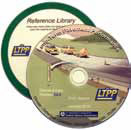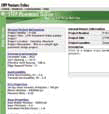U.S. Department of Transportation
Federal Highway Administration
1200 New Jersey Avenue, SE
Washington, DC 20590
202-366-4000
Federal Highway Administration Research and Technology
Coordinating, Developing, and Delivering Highway Transportation Innovations
| SUMMARY REPORT |
| This report is an archived publication and may contain dated technical, contact, and link information |
|
Publication Number: FHWA-HRT-10-072 Date: August 2010 |
View PDF (305 KB)
PDF files can be viewed with the Acrobat® Reader®
The Long–Term Pavement Performance (LTPP) program began in 1987 as part of the Strategic Highway Research Program (SHRP). Its primary purpose was to establish a national long–term pavement database to support pavement research and improved pavement performance. When SHRP ended as planned in 1992, the LTPP program continued under the Federal Highway Administration with the participation of highway agencies in all 50 States, the District of Columbia, Puerto Rico, and 10 Canadian Provinces.
Since 1989, the LTPP program has monitored nearly 2,500 pavement test sections throughout the United States and Canada. Approximately 950 test sections are still being monitored today. By collecting and analyzing data from these pavement test sections over time, researchers are gaining insight on how and why pavements perform as they do–learning how to build better, longer lasting, more cost–effective pavements.
Over the past 20 plus years of data collection, LTPP has produced a wide array of accomplishments and benefits and has created a variety of innovative products for highway agencies and researchers to utilize. Through partnership with key program stakeholders, the LTPP program has worked to fulfill each of its original objectives, with the ultimate goal of extending pavement life through better understanding of the factors that affect performance.
The program's single most significant product to date, as well as the largest source of information for current and future research, is the LTPP database. The database contains more research–quality data than have been collected anywhere before on the rate, type, and extent of pavement deterioration due to age, traffic loads, and weather, together with information on the design features and construction methods used to construct or rehabilitate the pavements.
LTPP data has contributed to more cost–effective highway pavements by providing
More realistic pavement design models.
Improved understanding of how and why pavements perform as they do.
High–quality data on which to base pavement management and rehabilitation decisions.
Guidance to support selection of the most cost–effective pavement design features for a given set of design constraints.
A knowledge base on which to develop educational curricula for future generations of pavement practitioners.
Researchers have examined many questions about pavement performance in the more than 600 publications produced using LTPP data. Many of their findings have led directly to cost–saving changes in highway agency practices. Here are a few examples:
The Colorado Department of Transportation (DOT) has been examining performance at its LTPP test sections and making improvements based on these evaluations. Two findings, derived directly from LTPP data, have led to improved practices for constructing portland cement concrete pavement: 1) widening a slab from 12 ft to 14 ft (3.7 m to 4.3 m) provides the structural equivalent of increasing slab thickness by 1 in. (2.54 cm); and 2) a single 1/8–in. (0.32–cm) cut is as effective as Colorado DOT's previous standard 3/8–in. (0.95–cm) double cut for PCC joints and provides a savings of $0.57 per linear foot ($1.87/m) of joint.
In Texas, researchers analyzed the relative cost–effectiveness of various maintenance treatments using ride quality and distress score data from LTPP test sites. Analysis showed that chip seals were a more cost–effective alternative compared to slurry seal and a 1–in. (25–cm) overlay.
The use of LTPP centers for calibrating falling–weight deflectometer (FWD) equipment by highway agencies and consultants revealed that many FWDs were significantly out of calibration. Proper calibration of this equipment has resulted in significant construction savings in situations where design is driven by FWD measurements. The Indiana DOT, for example, discovered that an FWD out of calibration by only 1 mil resulted in additional construction and maintenance costs of $17,900/mi. ($11,187/km).
LTPP performance data in a national study revealed that recycled asphalt pavement (RAP) and virgin hot–mix asphalt used in overlays of flexible pavements show approximately the same performance across a wide range of climates, traffic, and existing pavement conditions over a service life ranging up to 17 years. This major finding should give agencies confidence in specifying RAP mixtures for overlays when economic and other conditions warrant.
The LTPP program has generated savings across a wide range of pavement management activities, improving field data collection equipment and operations, establishing data variability and reliability, and providing quality data sets to be used for baseline comparisons against agency data. Many advances in data collection practices developed through LTPP research have been adopted by State/Provincial and local agencies–90 percent of State highway agencies report having used LTPP data collection equipment or test methods.
Numerous LTPP data collection procedures have been adopted by the American Association of State Highway and Transportation Officials (AASHTO) and industry, with the most widely implemented being the Distress Identification Manual.
For bound and unbound resilient modulus testing, the LTPP program established laboratory startup procedures to ensure that accurate, comparable results can be obtained. The procedures were developed specific to the resilient modulus protocols, but can broadly be applied to setting up closed–loop servo–hydraulic testing equipment. This procedure has been adopted by equipment manufacturers as a quality control check during equipment production.
Direct measurements at Seasonal Monitoring Program projects and automated weather station locations have provided designers and researchers with an abundance of high–quality environmental data. The further step of developing virtual weather stations has already paid significant dividends (an estimated $50 million per year for LTPPBind alone), and all environmental data will support significant future savings.
Improving material characterizations for bound and unbound layers is critical for advancing mechanistic–based designs. The LTPP program has provided many advances across this spectrum–from establishing testing protocols and increasing uniformity between testing labs to providing quality data for analysis activities. The Materials Reference Library will provide future analysts with the means to compare new test methods with actual performance using materials from LTPP projects.
For traffic and loading information, the LTPP Weigh–in–Motion (WIM) Cost Online and the LTPP WIM Smoothness Index software provide agencies with tools to evaluate the cost and pavement smoothness requirements for WIM installations. In addition, LTPP guidelines on calibrating and validating equipment allow loading and classification information to be used with confidence.
The LTPP database has played a critical role in the development and evaluation of every major pavement design methodology developed over the past 20 years. This includes the 1993 and 1998 AASHTO design procedures, SuperPave®, and–most recently–AASHTO's Mechanistic–Empirical Pavement Design Guide (MEPDG). This new pavement design procedure gives engineers improved tools for specifying the optimum mix, layer configuration, and thickness for new and rehabilitated pavements.
The MEPDG would not have been possible without LTPP data for many inputs. Calibrated nationally with LTPP sections, the MEPDG has shown significant reductions in the initial cost for heavily trafficked pavement designs, and its use is expected to generate annual savings of $1 billion.
The LTPP database is also serving as a critical tool in implementing the new design guide. For the MEPDG to be an effective resource for individual agencies, the national models need to be evaluated against local and regional performance to determine whether local calibration is required. Local validation and calibration will rely heavily on the LTPP database as many agencies do not otherwise have the data necessary to complete this endeavor.
Beyond overall design procedures, the LTPP data has supported and will continue to support model development and validation for a wide array of performance predictors and indicators.
The LTPP database will continue to be the single largest benefit from the LTPP program. Providing reliable pavement performance data to thousands of requestors throughout the academic community and the public and private sectors, the database has been the foundation for fundamental and applied research and the nucleus for advancements in pavement design and management processes. With the LTPP program continuing to enhance the quantity, quality, and accessibility of LTPP data, the database will be the catalyst for pavement advancements over the foreseeable future.
Future benefits will be achieved primarily through the exposure of engineers and researchers to the LTPP program and to the LTPP database. This has already begun, as many universities are incorporating the LTPP database in their undergraduate curricula. Familiarity with the program will facilitate the implementation of LTPP products–and increased exposure to LTPP products will result in applications beyond those currently envisioned.
Looking to the future, rehabilitating and maintaining existing pavements will become a much larger part of agencies' pavement programs and budgets. The LTPP program has many rehabilitated test sections that were monitored for several years before rehabilitation and that likely have several more years of service life after rehabilitation. Capturing the full performance life of these projects through continued monitoring in the coming years will lead to a deeper understanding of the treatment options and yield future savings.
Furthermore, because projects in Specific Pavement Studies 1 and 2, which examine structural factors in flexible and rigid pavements, are most relevant to learning how specific design features influence pavement performance, and many of these projects are not close to the end of their design lives, monitoring will continue. Data exist to support early conclusions, but additional information is necessary to learn the true impacts of these features over a pavement's entire design life.
The LTPP program is an ongoing activity that will yield additional benefits as data are added to the database and as new data analysis efforts are completed.
For more information on the LTPP program and how its products are being used to improve our highway system and ensure that our highway dollars are well spent, refer to the expanded version of this report, Long–Term Pavement Performance Program: Accomplishments and Benefits 1989-2009, and other resources at the LTPP Web site (www.fhwa.dot.gov/pavement/ltpp). In addition, an extensive database of LTPP reports, products, and research results is posted at http://ltpp.org/user_corner.shtml. Questions about LTPP data, products, and services can be directed to the LTPP Customer Support Service Center at ltppinfo@dot.gov.
The following is a sampling of products developed from the LTPP program. For more information, visit www.fhwa.dot.gov/pavement/ltpp/product.cfm.
 |
DataPave Online |

|
Rigid Pavement Design Software |
 |
Regional Falling-Weight Deflectometer Calibration Centers |
 |
Distress Identification Manual Provides a standardized means of identifying and recording cracks, rutting, spalls, potholes, and other evidence of pavement distress. The manual is now used by about half of the country’s State highway agencies, the FHWA, and many local agencies. www.tfhrc.gov/pavement/ltpp/reports/03031 New Link (https://www.fhwa.dot.gov/publications/research/infrastructure/pavements/ltpp/reports/03031) |
 |
LTPPBind Software Package Allows highway agencies to select the proper grade of asphalt binder for a specific location. Temperature models developed under the LTPP program make it possible to consider the extreme high and low temperatures expected at a pavement site in the binder selection process. Highway agencies are saving more than $50 million each year using the LTPPBind software package. www.fhwa.dot.gov/pavement/ltpp/ltppbind.cfm |
 |
Materials Reference Library |
Photo credits: Cover image, ©istockphoto.com/SandSun